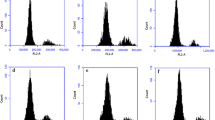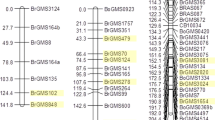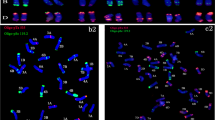Abstract
To develop doubled haploid (DH) mapping populations of hexaploid Brassica, 10 F1 hybrids derived from crosses between allohexaploid Brassica parents were evaluated in this study. The allohexaploid Brassica parents were selfed progenies of unique interspecific crosses between Brassica rapa (genome AA) × B. carinata (BBCC), B. nigra (BB) × B. napus (AACC), and a complex cross between B. juncea (AABB), B. napus and B. carinata, with relatively stable chromosome number (2n = 54). Hexaploid status and chromosome behavior during meiosis I in four promising F1 hybrids were assessed using microscopy and flow cytometry, and progeny were obtained following microspore culture. Hybrids H11-2 and H16-1 demonstrated higher amenability for embryo generation, plantlet regeneration, and frequency of production of DH microspore-derived progeny of hexaploid DNA content (6x) compared to hybrids H08-1 and H24-1. A total of 370 6x DH progeny were selected out of 693 plantlets from H11-2, 241/436 from H16-1, 23/54 from H08-1, and 21/56 from H24-1. DH progenies of hybrids H11-2 and H16-1 were then designated as promising mapping populations of a new hexaploid Brassica species.





Similar content being viewed by others
Abbreviations
- ANOVA:
-
Analysis of variance
- DH:
-
Doubled haploid
- MD:
-
Microspore-derived
- PMC:
-
Pollen mother cells
- PI:
-
Propidium iodide
- RFLP:
-
Restriction fragment length polymorphism
- SSR:
-
Simple sequence repeats
References
Ahmadi B, Alizadeh K, da Silva JAT (2012) Enhanced regeneration of haploid plantlets from microspores of Brassica napus L. using bleomycin, PCIB, and phytohormones. Plant Cell Tiss Org Cult 109:525–533
Ammar K, Mergoum M, Rajaram S (2004) The history and evolution of triticale. In: Mergoum M, Macpherson HG (eds) Triticale improvement and production (FAO plant production and protection paper 179). Food and Agriculture Organization of the United Nations, Rome, pp 1–9
Bennett MD (2004) Perspectives on polyploidy in plants-ancient and neo. Biol J Linn Soc 82:411–423
Busso C, Attia T, Robbelen G (1987) Trigenomic combinations for the analysis of meiotic control in the cultivated Brassica species. Genome 29:331–333
Chen S, Nelson MN, Chèvre AM, Jenczewski E, Li ZY, Mason AS, Meng JL, Plummer JA, Pradhan A, Siddique KHM, Snowdon RJ, Yan GJ, Zhou WJ, Cowling WA (2011) Trigenomic bridges for Brassica improvement. Crit Rev Plant Sci 30:524–547
Comai L (2000) Genetic and epigenetic interactions in allopolyploid plants. Plant Mol Biol 43:387–399
Cousin A, Nelson M (2009) Twinned microspore-derived embryos of canola (Brassica napus L.) are genetically identical. Plant Cell Rep 28:831–835
Dreisigacker S, Kishii M, Lage J, Warburton M (2008) Use of synthetic hexaploid wheat to increase diversity for CIMMYT bread wheat improvement. Aust J Agric Res 59:413–420
Dubcovsky J, Dvorak J (2007) Genome plasticity a key factor in the success of polyploid wheat under domestication. Science 316:1862–1866
Feldman M (2001) The origin of cultivated wheat. In: Bonjean AP, Angus WJ (eds) The World wheat book. Lavoisier Publishing, Paris, pp 1–56
Ferreira ME, Williams PH, Osborn TC (1994) RFLP mapping of Brassica napus using doubled-haploid lines. Theor Appl Genet 89:615–621
Ferrie AMR, Mollers C (2011) Haploids and doubled haploids in Brassica spp. for genetic and genomic research. Plant Cell Tiss Org Cult 104:375–386
Ge XH, Wang J, Li ZY (2009) Different genome-specific chromosome stabilities in synthetic Brassica allohexaploids revealed by wide crosses with Orychophragms. Ann Bot 104:19–31
Govil S, Babbar SB, Gupta SC (1986) Plant regeneration from in vitro cultured anthers of black mustard (Brassica nigra Koch). Plant Breed 97:64–71
Guo SM, Zou J, Li RY, Long Y, Chen S, Meng JL (2012) A genetic linkage map of Brassica carinata constructed with a doubled haploid population. Theor Appl Genet 125:1113–1124
Hetz E, Schieder O (1989) Plant regeneration from isolated microspores of black mustard (Brassica nigra). Science for plant breeding: XII Eucarpia congress, Göttingen, pp 10–15
Johnstone FE (1939) Chromosome doubling in potatoes induced by colchicine treatment. Am J Potato Res 16:288–304
Kimber DS, McGregor DI (1995) Brassica oilseeds: production and utilization. CAB International, Wallingford
Larter EN, Gustafson JP (1980) Triticale. In: Fehr WR, Hadley HH (eds) Hybridization of crop plants. American Society of Agronomy & Crop Science Society of America, Madison, pp 681–694
Leitch AR, Leitch IJ (2008) Genomic plasticity and the diversity of polyploid plants. Science 320:481–483
Levin DA (2002) The role of chromosomal change in plant evolution. Oxford University Press, New York
Li Z, Liu HL, Luo P (1995) Production and cytogenetics of intergeneric hybrids between Brassica napus and Orychophragmus violaceus. Theor Appl Genet 91:131–136
Li M, Qian W, Meng WJ, Li Z (2004) Construction of novel Brassica napus genotypes through chromosomal substitution and elimination using interploid species hybridization. Chromosom Res 12:417–426
Li MT, Li ZY, Zhang CY, Qian W, Meng JL (2005a) Reproduction and cytogenetic characterization of interspecific hybrids derived from crosses between Brassica carinata and B. rapa. Theor Appl Genet 110:1284–1289
Li MT, Zhang CY, Li ZY, Meng JL (2005b) The analysis of the biological characters in hexaploid hybrids derived from Brassica carinata and Brassica rapa. Acta Agron Sin 31:1579–1585
Liu B, Brubaker CL, Mergeai G, Cronn RC, Wendel JF (2001) Ployploid formation in cotton is not accompanied by rapid genomic changes. Genome 44:321–330
Mason A, Yan GJ, Cowling WA, Nelson M (2012) A new method for producing allohexaploid Brassica through unreduced gametes. Euphytica 186:277–287
Masterson J (1994) Stomatal size in fossil plants-evidence for polyploidy in majority of angiosperms. Science 264:421–424
Meng JL, Shi SW, Gan L, Li ZY, Qu XS (1998) The production of yellow-seeded Brassica napus (AACC) through crossing interspecific hybrids of B. campestris (AA) and B. carinata (BBCC) with B. napus. Euphytica 103:329–333
Mestiri I, Chague V, Tanguy AM, Huneau C, Huteau V, Belcram H, Coriton O, Chalhoub B, Jahier J (2010) Newly synthesized wheat allohexaploids display progenitor-dependent meiotic stability and aneuploidy but structural genomic additivity. New Phytol 186:86–101
Mohammadi PP, Moieni A, Ebrahimi A, Javidfar F (2012) Doubled haploid plants following colchicine treatment of microspore-derived embryos of oilseed rape (Brassica napus L.). Plant Cell Tiss Org Cult 108:251–256
Murphy EV, Zhang Y, Zhu W, Biggs J (1995) The human glioma pathogenesis-related protein is structurally related to plant pathogenesis-related proteins and its gene is expressed specifically in brain tumors. Gene 159:131–135
U N (1935) Genomic analysis in Brassica with special reference to the experimental formation of B. napus and peculiar mode of fertilization. Jpn J Bot 7:389–452
Nelson MN, Mason A, Castello MC, Thomson L, Yan GJ, Cowling WA (2009) Microspore culture preferentially selects unreduced (2n) gametes from an interspecific hybrid of Brassica napus L. × Brassica carinata Braun. Theor Appl Genet 119:497–505
Pradhan A, Plummer JA, Nelson MN, Cowling WA, Yan GJ (2010) Successful induction of trigenomic hexaploid Brassica from a triploid hybrid of B. napus L. and B. nigra (L.) Koch. Euphytica 176:87–98
Rahman MH (2001) Production of yellow-seeded Brassica napus through interspecific crosses. Plant Breeding 120:463–472
Raman H, Raman R, Nelson MN, Aslam MN, Rajasekaran R, Wratten N, Cowling WA, Kilian A, Sharpe AG, Schondelmaier J (2012) Diversity array technology markers: genetic diversity analyses and linkage map construction in rapeseed (Brassica napus L.). DNA Res 19:51–65
Saisingtong S, Schmid JE, Stamp P, Buter B (1996) Colchicine mediated chromosome doubling during anther culture of maize (Zea mays L.). Theor Appl Genet 92:1017–1023
Soltis DE, Soltis PS (1995) The dynamic nature of polyploidy genomes. Proc Natl Acad Sci USA 92:8089–8091
Takahira J, Cousin A, Nelson MN, Cowling WA (2011) Improvement in efficiency of microspore culture to produce doubled haploid canola (Brassica napus L.) by flow cytometry. Plant Cell Tiss Org Cult 104:51–59
Takashima H, Hasegawa H, Nakamura A (1995) A simple method for chromosome doubling in tobacco anther culture. Breed Sci 45:107–110
Tian E, Jiang Y, Chen L, Zou J, Liu F, Meng JL (2010) Synthesis of a Brassica trigenomic allohexaploid (B. carinata × B. rapa) de novo and its stability in subsequent generations. Theor Appl Genet 121:1431–1440
Winarto B, da Silva JAT (2011) Microspore culture protocol for Indonesian Brassica oleracea. Plant Cell Tiss Org Cult 107:305–315
Xu L, Najeeb U, Tang GX, Gu HH, Zhang GQ, He Y, Zhou WJ (2007) Haploid and doubled haploid technology. Adv Bot Res 45:181–216
Yu SC, Zhang FL, Yu RB, Zou YM, Qi JN, Zhao XY, Yu YJ, Zhang DS, Li L (2009) Genetic mapping and localization of a major QTL for seedling resistance to downy mildew in Chinese cabbage (Brassica rapa ssp pekinensis). Mol Breed 23:573–590
Zhang LQ, Liu DC, Yan ZH, Lan XJ, Zheng YL, Zhou YH (2004) Rapid changes of microsatellite flanking sequence in the allopolyploidization of new synthesized hexaploid wheat. Sci China Ser C 47:553–561
Zhang GQ, He Y, Xu L, Tang GX, Zhou WJ (2006) Genetic analyses of agronomic and seed quality traits of doubled haploid population in Brassica napus through microspore culture. Euphytica 149:169–177
Zhou WJ, Hagberg P, Tang GX (2002a) Increasing embryogenesis and doubling efficiency by immediate colchicine treatment of isolated microspores in spring Brassica napus. Euphytica 128:27–34
Zhou WJ, Tang GX, Hagberg P (2002b) Efficient production of doubled haploid plants by immediate colchicine treatment of isolated microspores in winter Brassica napus. Plant Growth Regul 37:185–192
Acknowledgments
This work was supported partly by the Science and Technology Department of Zhejiang Province (2012C12902-1, 2011R50026-5), the National Natural Science Foundation of China (31000678), and the Australia-China Special Fund, jointly managed by the Department of Innovation Industry Science and Research (Australia) and the Ministry of Science and Technology, National Natural Science Foundation (China). I.A. Astarini was the recipient of an Indonesian government Program of Academic Recharging (PAR). We thank Anouska Cousin for helping in microspore culture procedures.
Author information
Authors and Affiliations
Corresponding author
Additional information
X. X. Geng and S. Chen: equal first authors.
Rights and permissions
About this article
Cite this article
Geng, X.X., Chen, S., Astarini, I.A. et al. Doubled haploids of novel trigenomic Brassica derived from various interspecific crosses. Plant Cell Tiss Organ Cult 113, 501–511 (2013). https://doi.org/10.1007/s11240-013-0292-4
Received:
Accepted:
Published:
Issue Date:
DOI: https://doi.org/10.1007/s11240-013-0292-4




